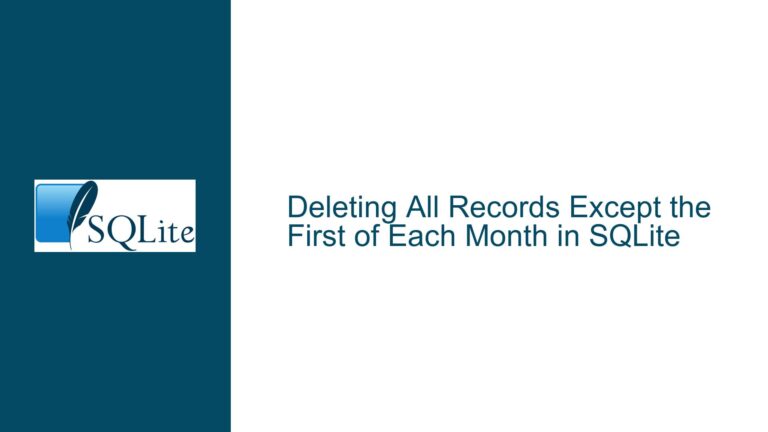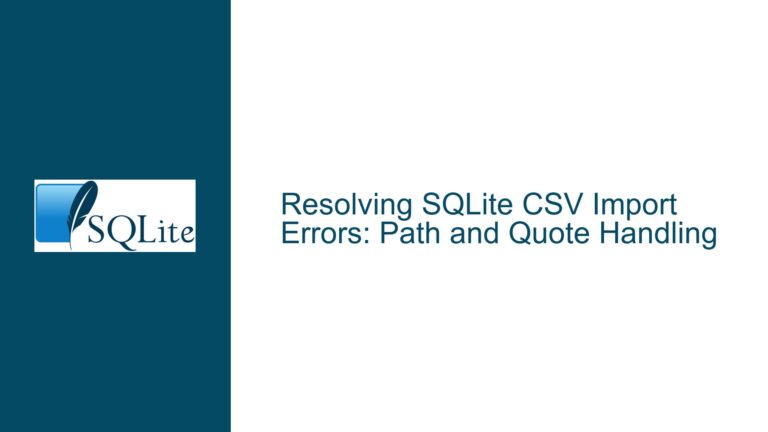Inconsistent Trigger Behavior in SQLite UPSERT Operations
Issue Overview: Inconsistent Trigger Behavior During UPSERT Operations
The core issue revolves around an unexpected behavior observed during an UPSERT operation in SQLite, specifically when a trigger is designed to detect hash collisions. The scenario involves two tables, t1 and t2, where t1 contains redundant BLOBs, and t2 is intended to store deduplicated versions of these BLOBs. A trigger, t2_collision, is created on t2 to detect and log any hash collisions that might occur during the deduplication process. The trigger is designed to fire only when a collision is detected, i.e., when the hash values are the same but the data values differ.
The unexpected behavior occurs when attempting to move data from t1 to t2 using an UPSERT operation. The UPSERT operation is intended to insert data into t2 if the hash value does not already exist, or update the existing row if a conflict is detected. However, the trigger fires incorrectly, logging a collision with an old.data value that does not exist in either t1 or t2. This behavior is inconsistent with the expected operation of the trigger and suggests a malfunction in the UPSERT implementation.
The issue was observed across multiple versions of SQLite, including versions 3.24.0, 3.45.1, and 3.46.0. The problem was traced back to the UPSERT implementation, which was introduced in SQLite version 3.24.0. The malfunction was subsequently fixed in the latest trunk check-ins and the branch-3.45 updates.
Possible Causes: Malfunction in UPSERT Implementation and Trigger Logic
The primary cause of the issue lies in the UPSERT implementation within SQLite. UPSERT, which stands for "UPDATE or INSERT," is a feature that allows for the insertion of a new row into a table if a conflict (based on a unique constraint) does not exist, or the updating of an existing row if a conflict is detected. The UPSERT operation is implemented as a special kind of transient trigger, which means that it operates in a manner similar to a trigger but is transient in nature.
The malfunction occurs because the UPSERT operation does not correctly handle the old and new values when a conflict is detected. Specifically, the old value, which should represent the existing row in the table, is incorrectly populated with data that does not correspond to any row in the table. This incorrect population of the old value causes the trigger to fire erroneously, logging a collision that does not actually exist.
Another potential cause of the issue is the interaction between the UPSERT operation and the trigger logic. The trigger, t2_collision, is designed to fire only when a collision is detected, i.e., when the hash values are the same but the data values differ. However, due to the malfunction in the UPSERT implementation, the trigger logic is not correctly evaluated, leading to the trigger firing inappropriately.
The issue is further compounded by the fact that the malfunction has persisted across multiple versions of SQLite, indicating that the problem is deeply embedded in the UPSERT implementation. The issue was not immediately apparent and required a thorough investigation to isolate the root cause.
Troubleshooting Steps, Solutions & Fixes: Identifying and Resolving the UPSERT Malfunction
To troubleshoot and resolve the issue, the following steps were taken:
Reproduction of the Issue: The first step in troubleshooting was to reproduce the issue in a controlled environment. This involved creating the tables
t1andt2, defining the triggert2_collision, and executing the UPSERT operation to move data fromt1tot2. The issue was consistently reproduced across multiple versions of SQLite, confirming that the problem was not isolated to a specific version.Analysis of the Trigger Logic: The next step was to analyze the trigger logic to ensure that it was correctly defined and that it was not the source of the issue. The trigger,
t2_collision, was designed to fire only when a collision was detected, i.e., when thehashvalues were the same but thedatavalues differed. The analysis confirmed that the trigger logic was sound and that the issue was not caused by an error in the trigger definition.Investigation of the UPSERT Implementation: The focus then shifted to the UPSERT implementation. The UPSERT operation is implemented as a special kind of transient trigger, which means that it operates in a manner similar to a trigger but is transient in nature. The investigation revealed that the UPSERT operation was not correctly handling the
oldandnewvalues when a conflict was detected. Specifically, theoldvalue was incorrectly populated with data that did not correspond to any row in the table, causing the trigger to fire erroneously.Isolation of the Root Cause: The root cause of the issue was isolated to a malfunction in the UPSERT implementation. The malfunction was traced back to the initial introduction of the UPSERT feature in SQLite version 3.24.0. The issue had persisted across multiple versions of SQLite, indicating that the problem was deeply embedded in the UPSERT implementation.
Implementation of the Fix: Once the root cause was identified, a fix was implemented in the latest trunk check-ins and the branch-3.45 updates. The fix addressed the malfunction in the UPSERT implementation, ensuring that the
oldandnewvalues were correctly populated when a conflict was detected. This prevented the trigger from firing erroneously and resolved the issue.Verification of the Fix: The final step was to verify that the fix resolved the issue. This involved re-running the UPSERT operation and checking the contents of the
collisionstable to ensure that no erroneous collisions were logged. The verification confirmed that the issue was resolved and that the trigger now operated as expected.
In conclusion, the issue of inconsistent trigger behavior during UPSERT operations in SQLite was caused by a malfunction in the UPSERT implementation. The malfunction resulted in the incorrect population of the old value, causing the trigger to fire erroneously. The issue was resolved by implementing a fix in the latest trunk check-ins and the branch-3.45 updates, ensuring that the old and new values were correctly populated during UPSERT operations. This fix restored the expected behavior of the trigger and resolved the issue.






